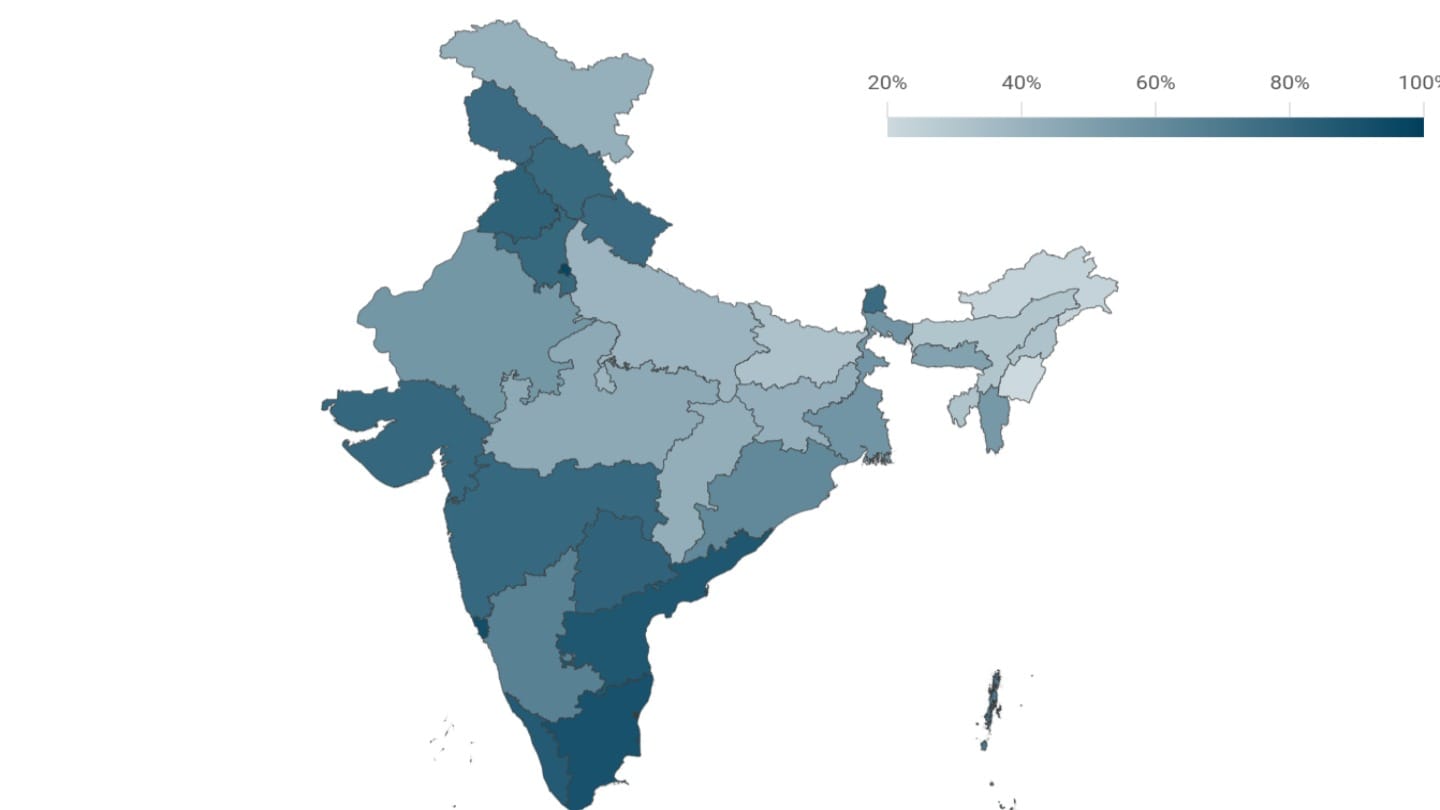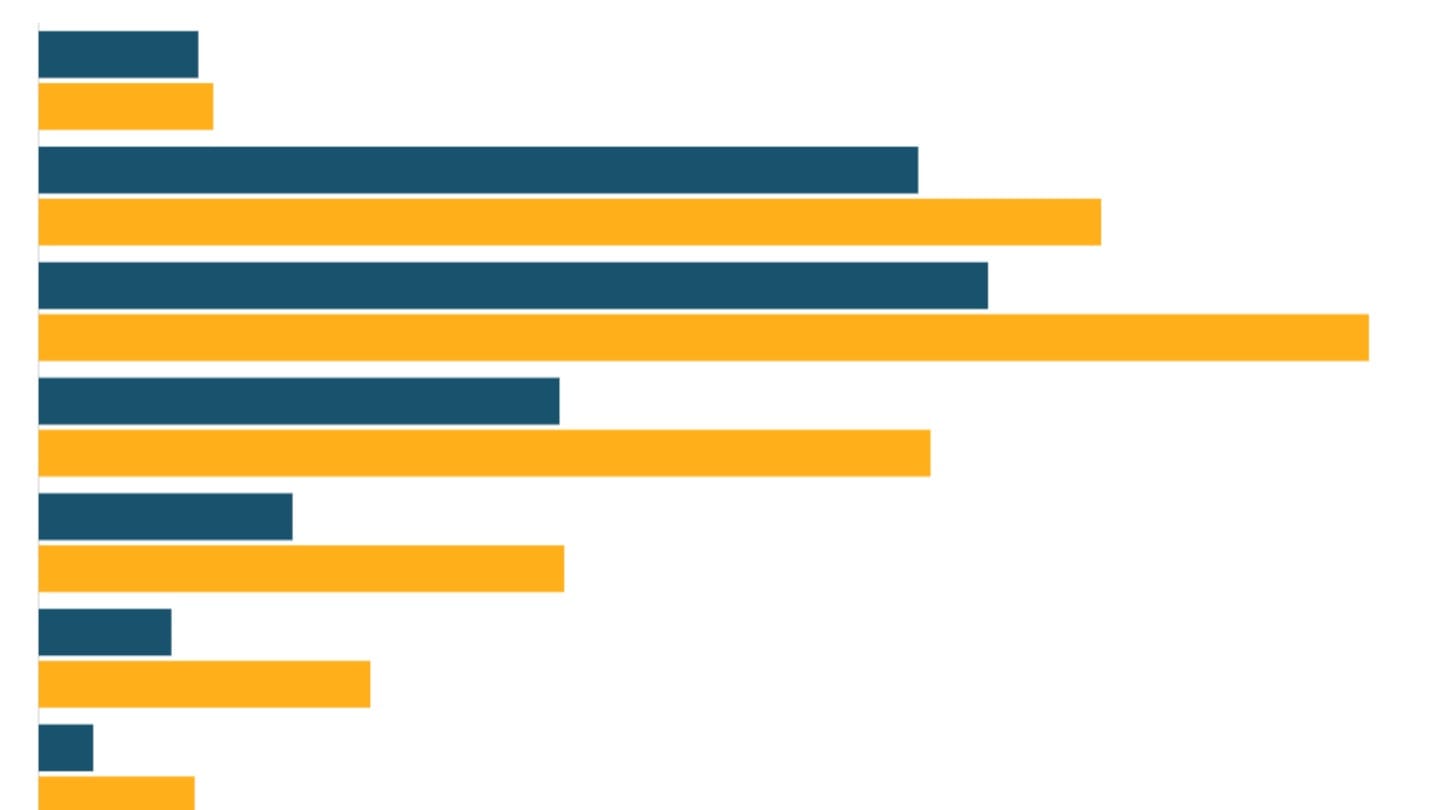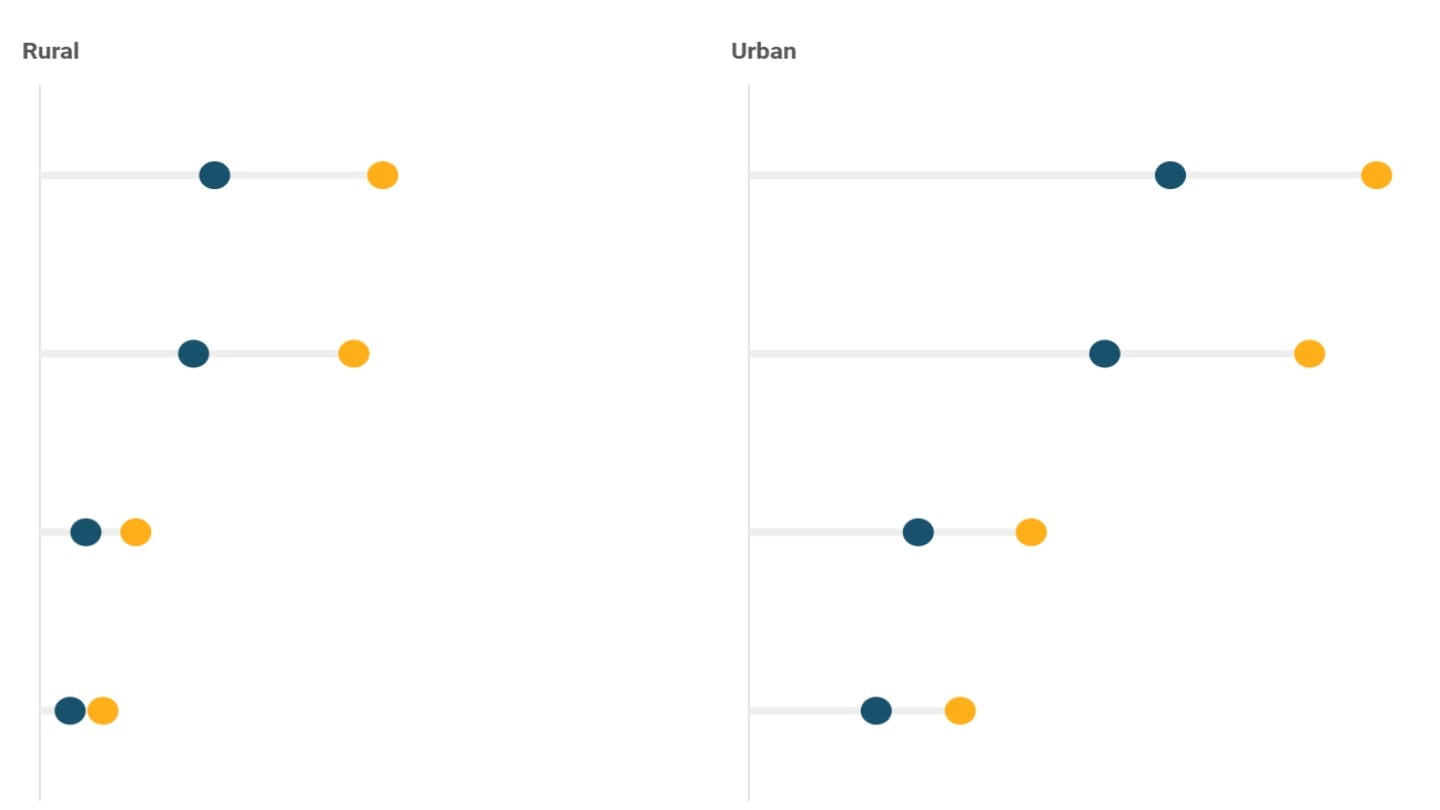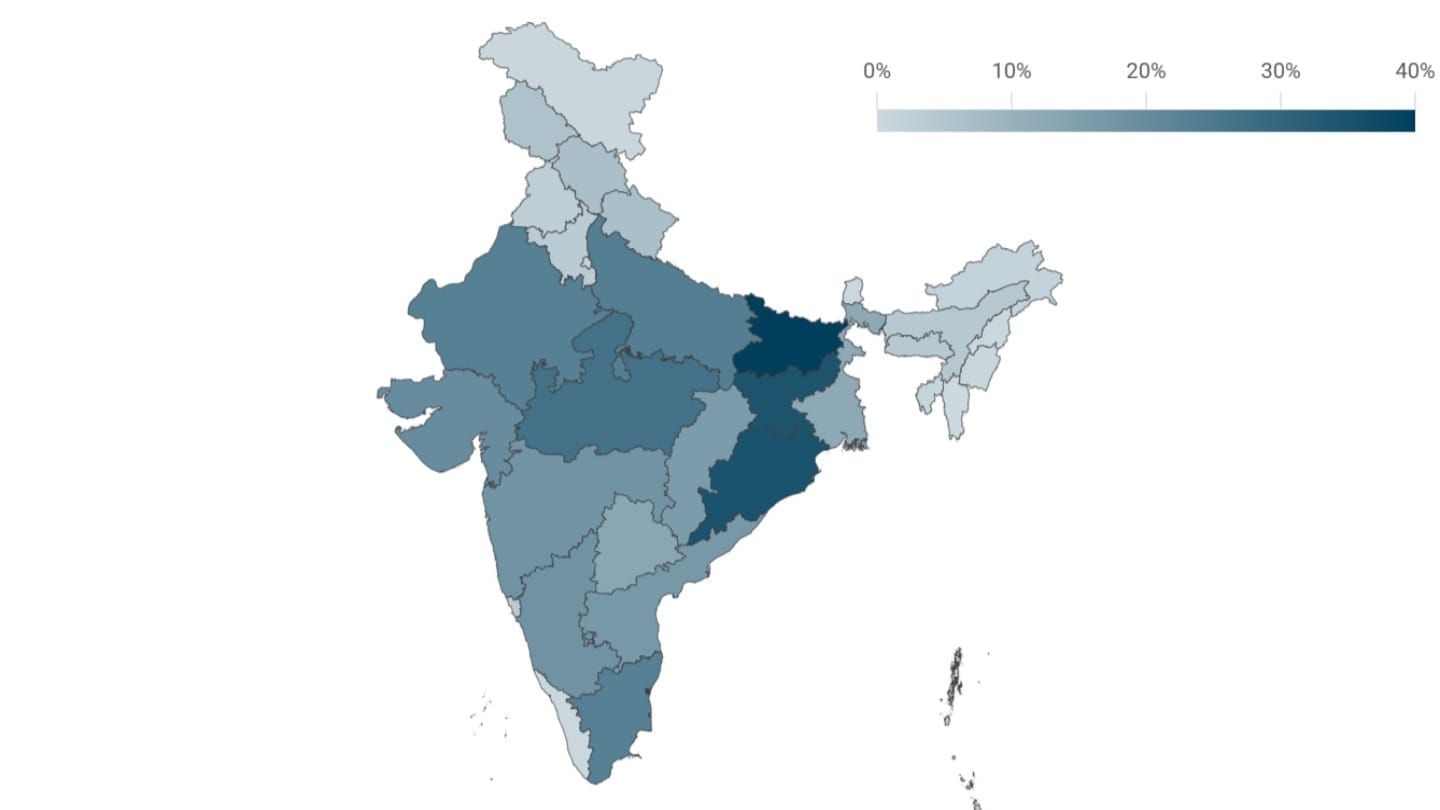Access to phones and the internet
The last two decades have seen a massive increase in the number of mobile phone connections in India. But not everyone uses phones and the internet in the same way.
Since the first mobile phone call in India was made in 1995, the rapid uptake of mobile phones and mobile internet has transformed the way Indians communicate, learn, work and shop.
Rise of the mobile phone
India has had landline phones for over 100 years, but their ownership remained limited. In 1999, 7% of Indian households owned a landline phone, and by 2005 it had peaked at 14% of households.[2] Today, less than 1% of homes have landline phones.[3]
Mobile phone ownership, on the other hand, took off rapidly, and democratised phone ownership in a way that landline phones were never able to. In 2008, there were 346 million registered mobile SIM cards in India. Between 2008 and 2024, this number more than tripled.
There are now over one billion active SIM cards[4] in India for a population of nearly 1.4 billion people.[5] With 81 mobile connections for every 100 people, India is 160th out of 208 countries in terms of mobile phone penetration.[6] Vietnam and Bangladesh are among the countries with more SIM cards than people, and in the world as a whole there are now more SIM cards than people.[7]
Mobile phone usage in India
Data on the number of registered mobile SIM cards does not capture how many people are using phones and who they are; some people and businesses may have more than one SIM card, while others may not be using phones at all. These gaps are filled in through data generated from household surveys, which ask people what they own and whether they use it.
To understand how many people actually use phones and who they are, we look at a nationally representative sample survey of over a million people conducted by the Indian government. The National Sample Survey Office's (NSSO) Comprehensive Annual Modular Survey asked respondents in 2022-23 about, among other things, their mobile phone and internet usage.[8]
The survey asked respondents whether they have used a mobile telephone with an active sim card for any amount of time during the last three months.[9] In 2023, 85% of adults or about 850 million people said yes.[10] About eight in ten women had used phones as against over nine in ten men.
A majority of Indian phone users, particularly among women, share their phone with a family member, and are not exclusive users of the device they use.
As of 2023, about 15% of Indians above the age of 15, or roughly 150 million people, said that they had not used a phone in the three months preceding the survey.
The non-usage of mobile phones is not on account of a lack of access. Nine in ten people who do not use a phone live in households that own a mobile phone.[11]
Three characteristics stand out among India's phone non-users: gender, education and age. More than seven in ten of those who do not use phones are women. The lack of phone usage is also highest among illiterates, and among the elderly.
Access to the internet
The rise of mobile phones also powered the spread of internet availability in India. In the ten years from 2014 to 2024, India added 30 million wired internet connections. In the same time, India added nearly 900 million mobile broadband connections.
Household surveys point to a similar expansion of household-level internet access; only 2% of homes in India had internet access in 2009, but once mobile broadband entered the space, the pace of access accelerated. By 2014, nearly three in ten homes had internet access and by 2023, about eight in ten homes were connected to the internet.[12]
Alongside household access, the usage of the internet has risen too. The nationally representative NSSO survey which asked individuals about their usage of the internet found that as of 2023, six in ten Indians had used the Internet at least once in the last three months.[13] In terms of internet use, India is roughly 100th of 160 countries.[14]
Internet usage is higher among younger, more urban, better educated and richer Indians.
For instance, while four in five Indians in their teenage and early twenties use the internet, only two in five Indians above the age of 60 use it.
With internet usage as well, the gender gap exists. While more than two-thirds of men had used the internet, only half of women had.
These gaps are sharper when it comes to internet usage than they are with phone usage, which is far more widespread.
The digitally disconnected
Although phones are the primary way of accessing the internet, not everyone with a mobile phone uses the internet. More than a third of women who use phones do not use the internet.
A small, and shrinking, share of Indians have used neither a phone nor the internet recently. While fewer than one in ten men had used neither the phone nor the internet, more than one in five women had not used either.
Those who had not used the phone or the internet tended to be elderly or were more likely to belong to poorer households.
Pandemic-driven spikes
The global coronavirus pandemic accelerated technology adoption in India. In just the three years between 2020 and 2023, phone usage rose from 70% of adults to 85%.[15]
Phone use has increased dramatically among children and teenagers as well. Among children between the ages 5 and 14, one in six had recently used a mobile phone in 2020, but by 2023, this had risen to nearly four in six children. Teenagers are now more likely to have used mobile phones recently than people in their forties.
Inequities in phone usage - among the rural and urban populations, between men and women, and among the rich and poor - are also narrowing. While phone usage among the poorest men grew from 74% to 84% in three years, it grew from 39% to 67% for the poorest women.[16] The gender gap in phone usage nearly vanishes among children.
The gender gap in internet use has also shrunk fast over the past few years. A nationally representative survey in 2019-2021 found that 33% of women and 54% of men between the ages of 15 and 49 used the internet. In 2023, the prevalence increased to 63% among women and 76% among men in the respective age groups.[17]
[1] The Multiple Indicator Survey, or MIS (NSS Round 78, 2020), was the first large survey from the National Sample Survey Office to record the use of mobile phones among India's population. The National Family Health Survey recorded phone and internet use. Data For India used these surveys for its article on access to phones and internet published in March 2024.
In October 2024, the NSSO published data for the Comprehensive Annual Modular Survey (CAMS) (NSS Round 79), which was conducted in 2022-23. Since CAMS is as large and representative as MIS, Data For India has revised its original piece on phone and internet use using the new data.
[2] National Family Health Survey rounds 2 (1999) and 3 (2005).
[3] Comprehensive Annual Modular Survey (NSS Round 79)
[4] As of the August 2024, after excluding out-of-service and out-of-use SIM cards
[5] Official projection for 2024 by Registrar General of India, the national Census authority
[6] World Bank World Development Indicators (data is sourced from the International Telecommunication Union). Data refers to the year 2022.
[7] According to the International Telecommunications Union (ITU), the world had close to 9 billion SIM cards by 2023
[8] The Comprehensive Annual Modular Survey (CAMS) was conducted in the 79th round of National Sample Surveys (NSS). It captures a host of individual and household characteristics of Indians, including mobile phone and internet usage.
[9] The survey first asked if respondents were able to use phones. To respondents who reported they were able to use a mobile phone, the survey asked the question: whether [the respondent] uses any mobile telephone (including smartphone) with [an] active sim card for the last three months? (yes: exclusive use; yes: shared with household member; yes: shared with non-household member; no). The share of those not using phones was the sum of those who answered no to the first and to the second questions.
[10] We look at the population above age 15 for this question. According to the official projections by the Government of India, there were a little more than 1 billion Indians above 15 in 2023.
[11] The Comprehensive Annual Modular Survey (CAMS) asks the head of the household whether the household has a mobile phone, and asks individual household members if they use a mobile phone.
[12] NSS 66th Round (2009-2010), Household Consumer Expenditure Survey, asked the head of the household whether the "household has access to internet at home on the date of survey". NSS 71st round (2014), Social Consumption, Education Survey asks the question slightly differently: "If any member of the household aged 14 years & above has access to [use] internet facility, then the household would be considered as having internet access." The Comprehensive Annual Modular Survey (CAMS) (NSS Round 79, 2022-23) asks households whether they have access to a broadband internet facility within the household premises.
[13] The Comprehensive Annual Modular Survey (CAMS) asks individual respondents whether the respondent has used the internet at least once during the three months preceding the survey. For those who respond "no" to this question, the CAMS further asks if the respondent used the internet at least once during the last 12 months. Internet usage among the 15+ population was 58% in both the 3-month and 12-month reference periods.
[14] The International Telecommunication Union (ITU) records the proportion of individuals who used the Internet from any location in the last three months (via fixed or mobile network). It uses data officially provided by national statistical offices and telecommunication ministries. We consider countries with more than a million people.
[15] 2020:The Multiple Indicator Survey (NSS Round 78). 2023: Comprehensive Annual Modular Survey (NSS Round 79)
[16] The poorest among both women and men refers to the lowest fifth of the population according to the monthly per capita consumption expenditure.
[17] The 2019-2021 data refers to the National Family Health Survey, where the question on internet use was asked to women between the ages of 15 and 49, and men between the ages of 15 and 54. The 2023 survey (CAMS) asks the internet use question to all men and women, but the data presented here pertains to the aforementioned age groups.




